AVATAR: THE WAY OF WATER (2022)
A familiar threat returns to finish what was previously started, so Jake must work with Neytiri and Na'vi race to protect their home.
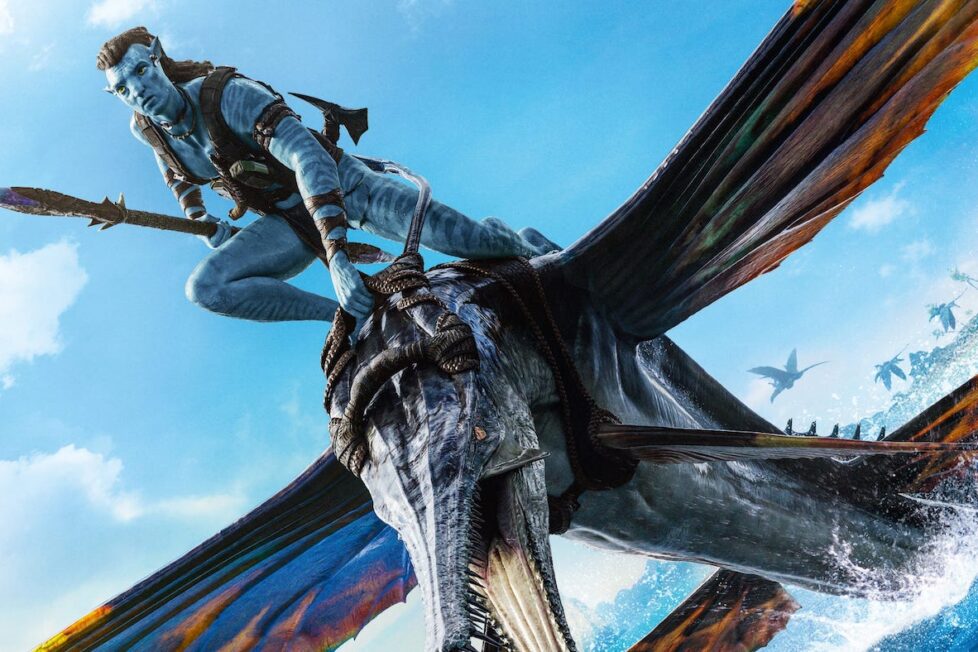
A familiar threat returns to finish what was previously started, so Jake must work with Neytiri and Na'vi race to protect their home.


James Cameron’s one of the most successful directors there’s ever been, but nowhere near the most prolific. Avatar: The Way of Water is only his eighth feature film in almost 40 years (ignoring Piranha II: The Spawning), but he’s rightly acclaimed for his technical mastery, talent for crafting worthwhile sequels (Aliens, Terminator 2: Judgment Day), and for taking big creative swings that often leave critics eating humble pie as risky projects like Titanic (1997) and Avatar (2009) become the highest-grossing movies of their time. An achievement Avatar still holds, having regained its title after Avengers: Endgame (2019) momentarily took its crown. Cameron hasn’t made a movie in the 13 years since Avatar grossed a phenomenal $2.9BN, so The Way of Water heralds his return to cutting-edge filmmaking where Disney will be hoping his Midas Touch hasn’t gone soggy…
A decade after the events of Avatar, Jake Sully (Sam Worthington) is now chief of the Omaticaya clan and raising a family with Neytiri (Zoe Saldaña), which includes their teenage sons Neteyam (Jamie Flatters) and Lo’ak (Britain Dalton), younger daughter Tuk (Trinity Jo-Li Bliss), adopted daughter Kiri (Sigourney Weaver), and an adolescent boy called Spider (Jack Champion) who was left behind on Pandora as a baby when the defeated human invaders returned home. He also happens to be the biological son of villain Quaritch (Stephen Lang), who died in battle against Jake and the Na’vi.
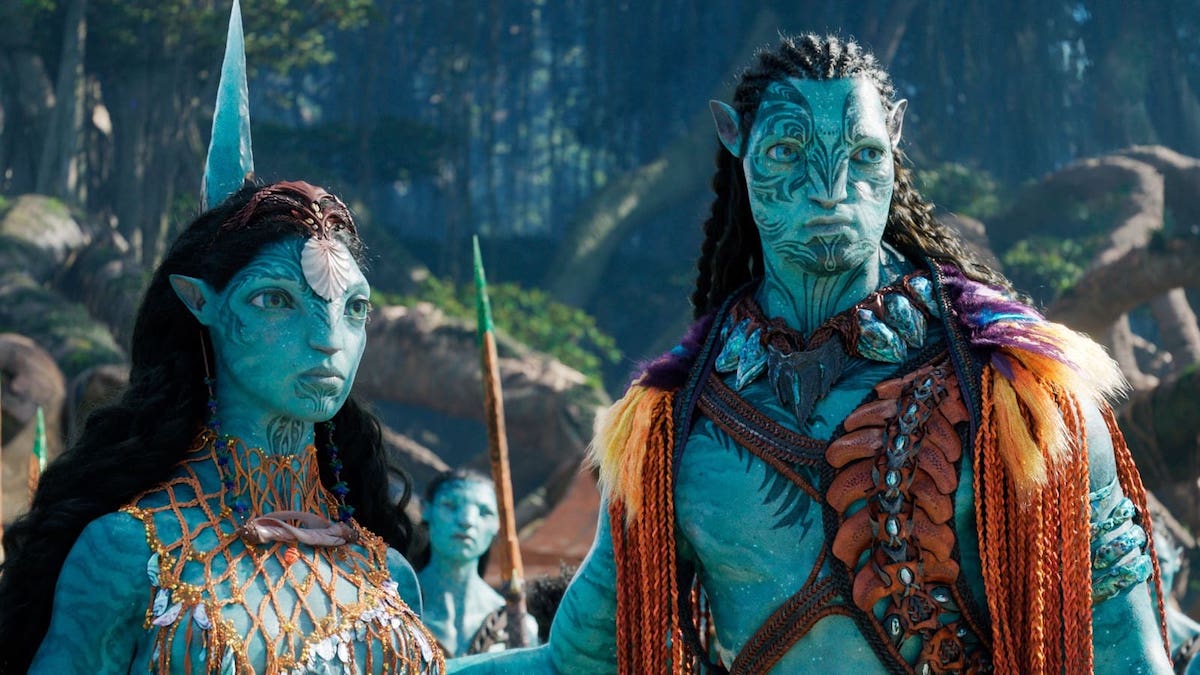
The Way of Water is a rudimentary blockbuster sequel in the sense it’s almost the same movie but with a few tweaks and expansions. The human invaders (or “Sky People”) return to Pandora looking to colonise the planet because Earth is now dying—including so-called ‘recombinants’ (Na’vi bodies implanted with the memories of dead soldiers, which includes the aforementioned Quaritch, who’s looking to avenge his human progenitor’s death by going after Jake). This forces Jake and Neytiri to leave their forest home and seek refuge with the nearby Metkayina clan, led by chief Tonowari (Cliff Curtis), whose people are physically adapted to an ocean environment with longer tails, finned forearms, and more muscular physiques.
This film follows almost exactly the same beats as Avatar, only now the personal jeopardy is heightened for Jake because now he has a large family to protect. Familiar issues of being an ‘outsider’ also echo throughout the movie again, only now Jake’s weird status as a ‘human avatar’ is rarely mentioned and prejudice is instead aimed at his kids because they’re tree-swingers and not sea-swimmers. They’re also human-Na’vi crossbreeds with five fingers instead of four, making them freaks in the eyes of many.
The Way of Water is essentially Round 2 between the technologically superior humans and the native Na’vi, only now Quaritch and his team are a physical match for the tribes they want to eradicate. Even mankind’s previous interest in Unobtanium isn’t mentioned but replaced halfway through with a new greed for a whale’s brain enzyme called amrita that can stop human ageing. (A development that doesn’t really go anywhere, but will presumably be explored in subsequent films and perhaps allow for some of the human characters to still be knocking around many generations hence.)
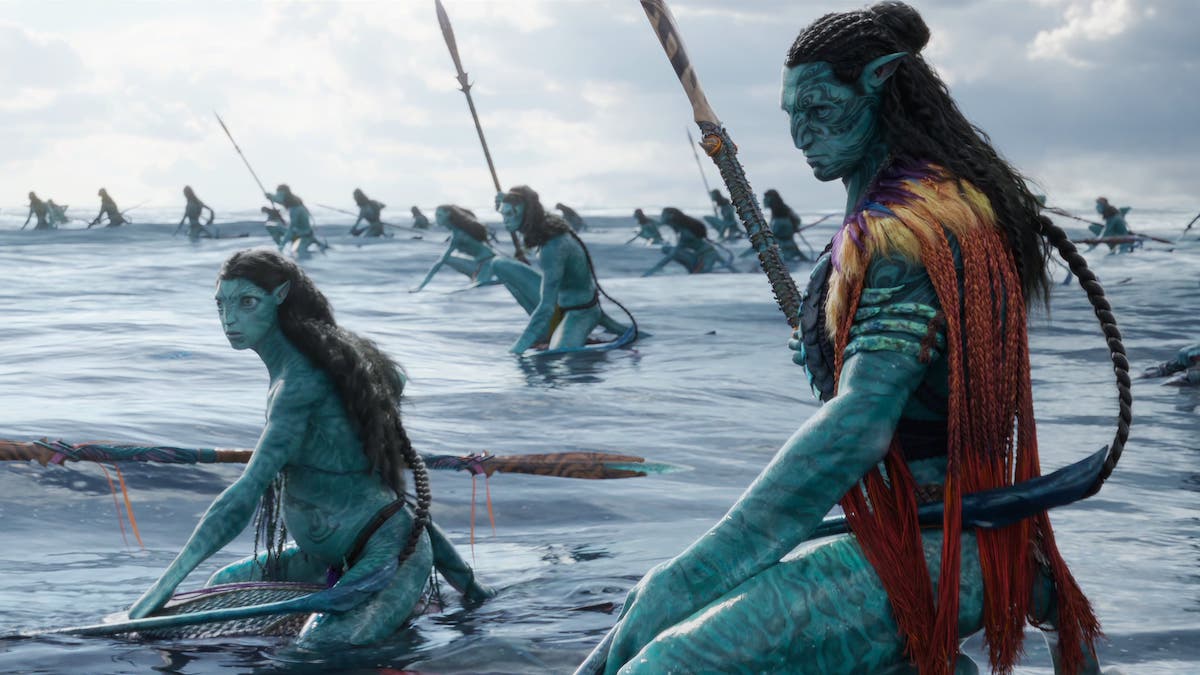
It’s not a huge problem that The Way of Water doesn’t offer anything substantially different to Avatar, as chances are you haven’t seen the original many times since 2009—as it continues to be perceived more as a 3D experience than something equally satisfying to watch in 2D at home. I confess I’d forgotten specifics about what happened before, so questions about Spider’s existence and how Kiri came to be born from Dr Grace Augustine (Weaver) washed over me a little. It’s not essential to know these things going in, but The Way of Water perhaps unreasonably assumes we’re more familiar with Avatar than most really are, as online debate about its “cultural significance” is persuasive in the sense nobody’s been chomping at the bit to see what happens to Jake and Neytiri next. Or certainly not in the way people were desperate for more after seeing The Matrix (1999) or The Lord of the Rings: The Fellowship of the Ring (2001). For Cameron to deliver much the same experience—with only a family perspective and ocean environments being noticeable differences—is questionable, but knowing there’s another sequel due in 2024 (and possibly two more) quells misgivings. One suspects the 2009 Avatar will eventually feel like a pseudo-prequel to this main story of a ‘mixed race’ family leading a war against people who mean them harm and don’t care for the ecological balance of their homeworld.
Many argue the pros and cons of the Avatar franchise’s position as a somewhat formulaic story utilising well-worn tropes of the ‘white saviour’, and how Cameron’s heart’s in the right place but he tackles themes rather bluntly and from a rich white person’s position of privilege. There’s undoubtedly merit in hearing these arguments and it’s true these films make creative decisions it might have been better to avoid—like why do all Pandora’s indigenous tribes mirror what ‘white people’ consider foreign tribes here on Earth? Why does white boy Spider need to have dreadlocked hair appropriating black culture too? It would be fascinating if the Avatar movies did something more radical and gave us truly alien tribes that aren’t all created from a Caucasian idea of ‘the other’, only with added blue skin and cat noses. Imagine if Jake had been played by a black actor and the Na’vi were more like European neanderthals, perhaps?
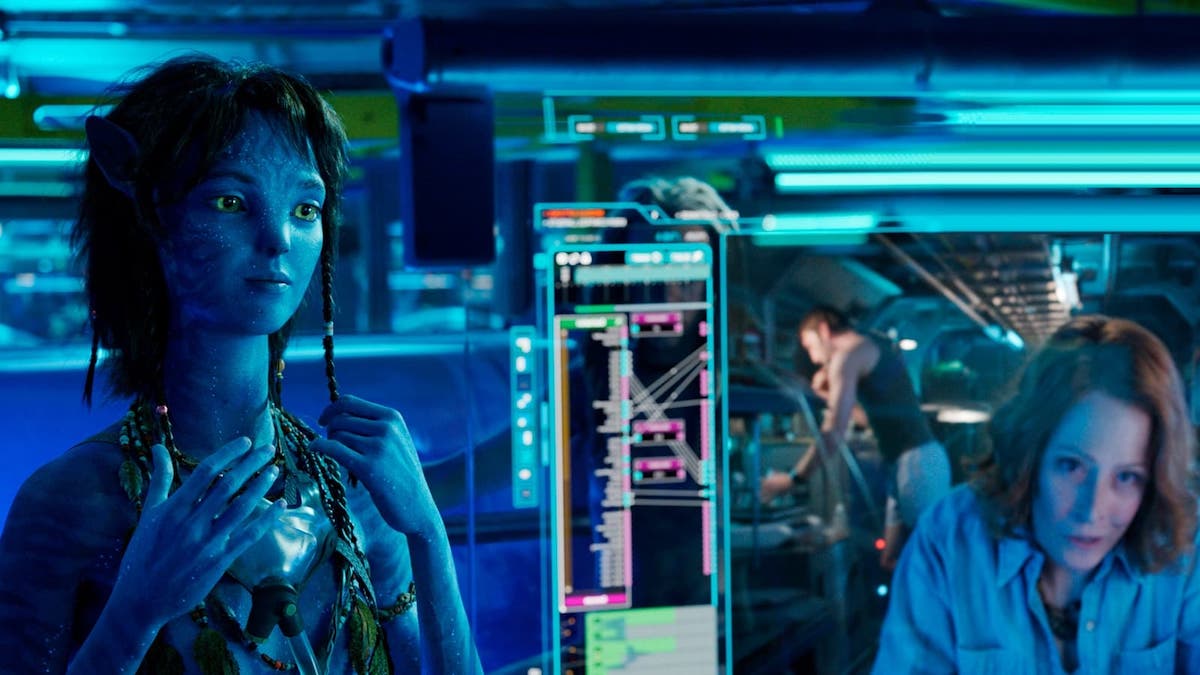
The Way of Water also misses a few juicy opportunities for storytelling, with the caveat that Avatar 3 may deal with them. I was excited to see Quaritch’s reaction to waking up in the giant body of a creature he reviles, but the story doesn’t even touch on the idea there may be a degree of self-loathing there. So maybe there isn’t and Quaritch loves being a Na’vi now? But even that hatred mixed with jealousy for their physical abilities would be interesting to comment on.
It was such a fascinating part of Avatar that a crippled human was reborn as an agile alien, so it seems like a wasted opportunity for Quaritch to not experience a less harmonious version of Jake’s journey from last time. The film also has an interesting idea that the resurrected Quaritch gets to meet his infant son, who’s been raised by his nemesis and the man he believes killed him, but the story doesn’t do much with any of that. A fight for Spider’s heart and mind is right there for the taking—does the boy side with his gung-ho father and come to see things from mankind’s point-of-view, or does he continue to want to emulate his blue-skinned ‘brothers and sisters’ because he’s been raised like a young Tarzan? The Way of Water leaves these things mostly alone. Perhaps a few subplots were jettisoned due to runtime concerns, as the film is already over three hours long.
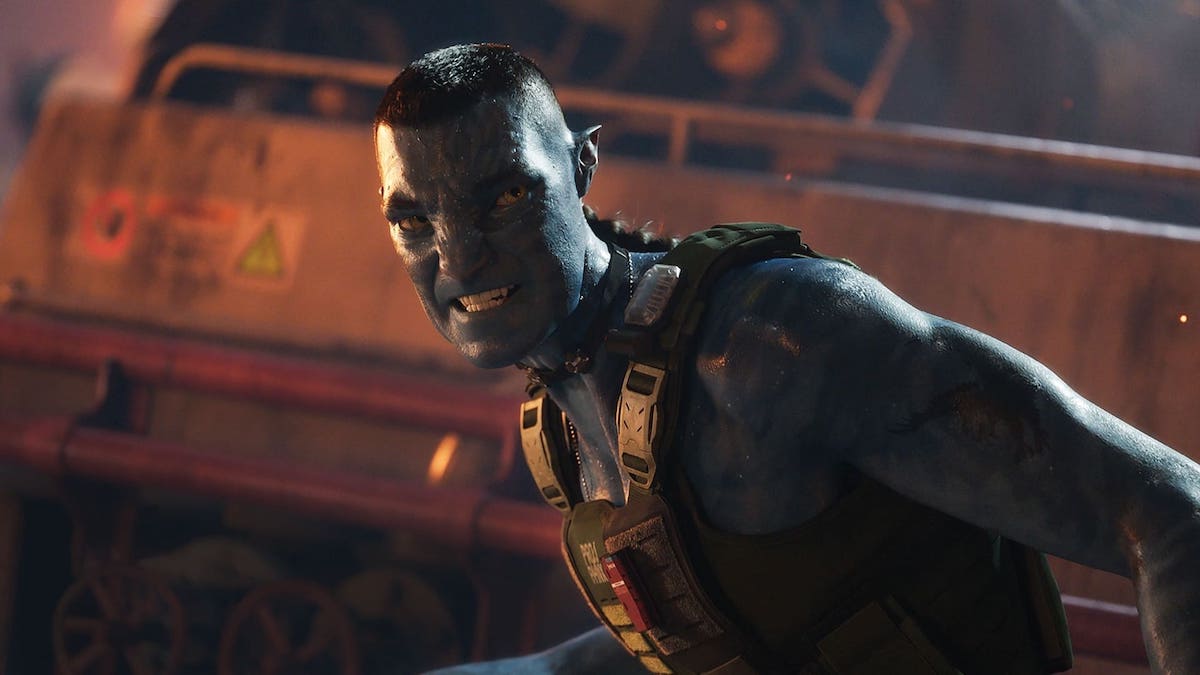
Unsurprisingly, Avatar: The Way of Water is a masterpiece of VFX filmmaking on the grandest scale possible. The budget is rumoured to be around $460M and there aren’t A-list stars with enormous salaries taking up a third of the production costs, as there are with the similarly epic Avengers films. And every penny is there to see. James Cameron is undoubtedly the world’s most talented director in terms of understanding cutting-edge filmmaking technologies in terms of performance capture, creating complex digital worlds, and the best ways to use 3D and variable-frame-rate (VFR). He also has the creative freedom, timescale, and money to make a movie like The Way of Water achieve its aims as an audio-visual experience. There’s no feeling of cost-cutting or resources stretched thin at any point; no wonky VFX moment or a poor piece of digital integration. It’s all so convincing one doesn’t question what you’re seeing, which creates a deep sense of transportation. It’s a joy to behold. The 3D may not seem game-changing as it did when Avatar debuted (it was also the first 3D I’d ever seen), but perhaps I should have sought out an IMAX experience. It’s also wise that Cameron doesn’t use 3D to noticeably thrill and delight audiences for the sake of it—with objects protruding out of the screen and things levitating near your head. The 3D remains more of a window into another world where things like a character’s facial contours seem tangible and there’s a sense of scale and distance to everything you’re looking at.
Overall, the return trip to Pandora is worth the wait in terms of spectacle and James Cameron cribs from his T2 playbook in almost remaking the first movie with a more physically challenging villain and a family dynamic at the core. There are plenty of missed opportunities along the way, and nothing significantly interesting happens that’s going to keep audiences excited as we wait for the third film, but the three hours fly by and it’s an accomplished piece of blockbuster filmmaking that showcases what modern VFX is capable of in the right hands and with no thriftiness. There’s nothing here to outright hate and a fair bit to love, but I hope Avatar 3 switches gears and does something that feels very different and fresh.
USA | 2022 | 192 MINUTES | 2.39:1 (THEATRICAL) • 1.90:1 (IMAX) | COLOUR | ENGLISH

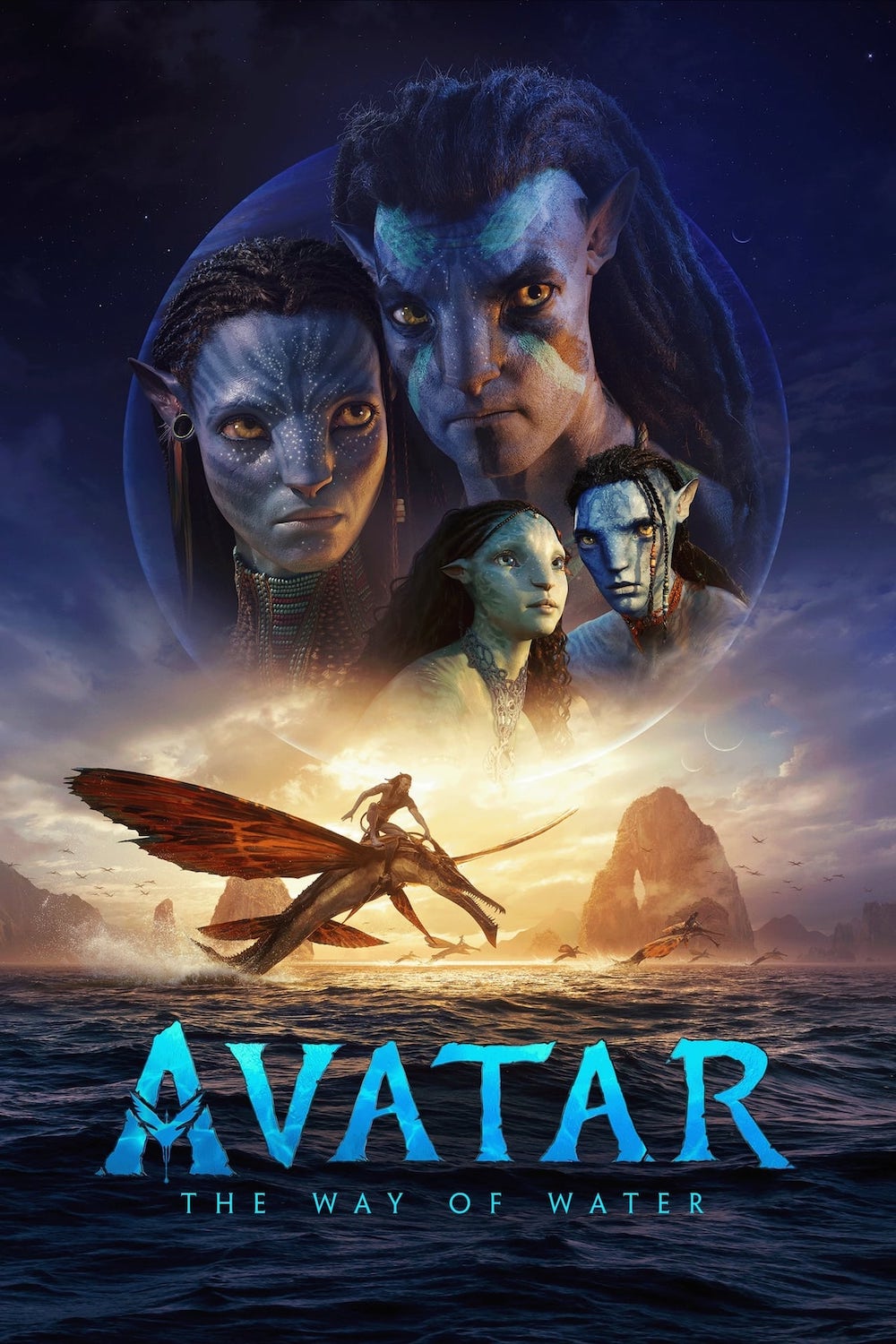
director: James Cameron.
writer: James Cameron, Rick Jaffa & Amanda Silver (story by James Cameron, Rick Jaffa, Amanda Silver, Josh Friedman & Shane Salerno).
starring: Sam Worthington, Zoe Saldaña, Sigourney Weaver, Stephen Lang, Kate Winslet, Cliff Curtis, Edie Falco, Jemaine Clement, Jack Champion, Giovanni Ribisi, CCH Pounder & Brendan Cowell.
